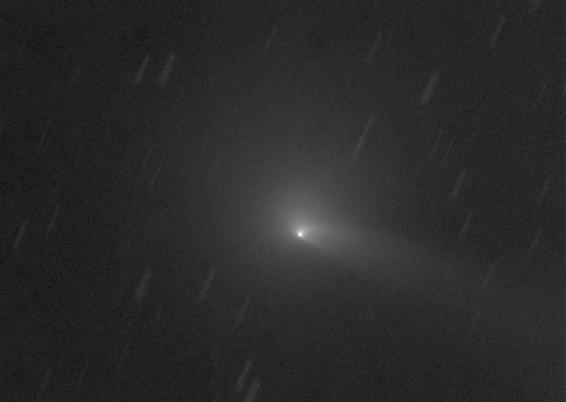COMET HIGHLIGHTS FOR JULY 2014
2014-July-1
Section Updates
During June the Comet Section received images from Frank Melillo and Carl Hergenrother of comets C/2012 K1 (PANSTARRS) and C/2013 UQ4 (Catalina). Numerous positive visual and CCD magnitude estimates by Salvador Aguirre (2), John Sabia (3) and Carl Hergenrother (6) have been submitted for comets C/2012 K1 (PANSTARRS), C/2012 X1 (LINEAR) and C/2013 UQ4 (Catalina).
Evening Comets
C/2012 K1 (PANSTARRS) [Perihelion on 2014-Aug-27 at 1.05 AU from the Sun]
Comet PANSTARRS will spend most of July too close to the Sun to be observed. Observations during the first week of July are still possible in the evening sky though the Moon will interfere. Once the comet is lost in the glare of the Sun, it will be invisible to ground-based observers till September though SOHO will be able to image the comet in early August. So far we have received 29 visual magnitude estimates of this comet from 3 observers. Observations over the past month suggest that K1’s rate of brightening has slowed with recent observations placing the comet around 8th magnitude. We’ll have to wait and see what how bright this comet will be when we see it again in September.
Timing is everything with comets. This time around, PANSTARRS reaches perihelion when it and the Earth are on opposite sides of the Sun. If PANSTARRS had reached perihelion near February 21, it would be located only 0.11 AU from Earth and might be a brilliant 1st to 2nd magnitude comet near opposition. Over the course of a week or so it would have raced from Virgo westward into Eridanus.
Recent ALPO images and observations of C/2012 K1 (PANSTARRS) can be found in the Comet Section Image Gallery and Magnitude Repository. Finder charts for C/2012 K1 can be found on the Comet Chasing website.
Morning Comets
C/2012 X1 (LINEAR) [Perihelion on 2014-Feb-21 at 1.60 AU from the Sun]
Visual observers have followed this comet for over 9 months. It literally “burst” onto the scene in late October when it experienced a large outburst and brightened to 7th magnitude. A few weeks after the outburst the comet settled back down and has been well behaved since then. It spent much of February/March/April/May between magnitude 8.0 and 8.5. Over the past month or so X1 has been in a rapid fade and is now near magnitude 10.0. The comet should rapidly fade from the reach of visual observers this month. Though it is approaching opposition, it is also moving south starting the month at a declination of -31° in Piscis Austrinus and ending the month in Grus at -44°. The Section has received 30 visual magnitude estimates for this comet.
Finder charts for C/2012 X1 can be found on the Comet Chasing website. Its ALPO image gallery can be found here.
C/2013 UQ4 (Catalina) [Perihelion on 2014-Jul-05 at 1.08 AU from the Sun]
This odd-ball of a comet is making a close approach to within 0.32 AU of Earth on July 10. I say odd-ball because for months after discovery it appeared as an inactive asteroid. Though it has not brightened as much as hoped (still around 10th magnitude as of 7/1), it has become a very photogenic comet with strong dust jets and a large gas coma. The comet starts the month at a distance of 1.08 AU from the Sun and 0.48 AU from Earth in Pegasus. It moves quickly through Andromeda, Lacerta, Cepheus, and Draco before ending the month in Bootes at a 1.16 AU from the Sun and 0.84 AU from Earth. It should reach its peak brightness at magnitude ~9 around the time of close approach to Earth.
Finder charts for C/2013 UQ4 can be found on the Comet Chasing website. Its ALPO image gallery can be found here.
C/2014 E2 (Jacques) [Perihelion on 2014-Jul-02 at 0.67 AU from the Sun]
Jacques reaches perihelion on July 2nd at a distance of 0.67 AU from the Sun. Unfortunately, as was the case with C/2012 K1, it is too close to the Sun and on the far side of the Sun at that time. During June our only view of the comet was with the coronagraphic imager on the SOHO spacecraft (you’ll find some of these images in the ALPO Comet Section Image Gallery). The comet was not very impressive in the SOHO images and it is very possible that it is running fainter than hoped. We’ll catch another glimpse of the comet during the second half of July as it emerges from the glow of dawn moving north from Taurus into Auriga. The comet may be as bright as magnitude 6 or 7 at that time.
Recent ALPO images and observations of C/2014 E2 (Jacques) can be found in the Comet Section Image Gallery and Magnitude Repository. Finder charts can be found on the Comet Chasing website.
As always, the Comet Section is happy to receive all comet observations, whether images, drawings or magnitude estimates.
- Carl Hergenrother (ALPO Comet Section Coordinator)




